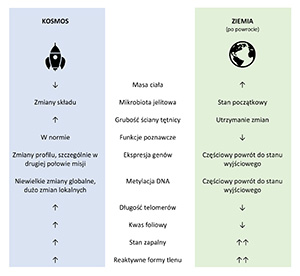Epigenetic on Earth and in Space
DOI:
https://doi.org/10.18388/pb.2021_437Abstract
The year 1961 went down in history with exceptional scientific achievements. On May 13, the journal Nature published two articles on the first isolation of messenger ribonucleic acid (mRNA), which is an intermediate product between a gene and a protein. Just two weeks later, on May 27, the first letter of the genetic code, phenylalanine, was discovered. These discoveries made it possible to understand how genetic information is encoded and processed, thus causing the dynamic development of molecular biology. The breakthroughs of 1961 concerned not only nucleic acids. On April 12, the first human, Yuri Gagarin, entered space. Eight years later, in 1969, Neil Armstrong made his first walk on the moon, uttering the famous phrase: It is a small step for man, but a great leap for humanity. The era of conquering and learning about the cosmos has begun, mainly motivated by the natural curiosity of man and the desire to learn about the surrounding reality. The environmental factors in space are very different from terrestrial conditions, which raises questions about their effects on living organisms. In search of answers, a variety of scientific research has been carried out at the International Space Station (ISS) for over twenty years. As space travel is set to become more common in the near future, detailed studies of the effects of long-term space missions on the human body are required. These studies are currently carried out, among others using molecular biology techniques that enable detailed analysis of nucleic acids and proteins, but not only. The breakthrough achievements of 1961 initiated the development both in the field of molecular biology and the science of space, thanks to which today, 60 years after those events, we can combine knowledge and technological achievements from both fields to analyze and understand changes at the molecular level that occur as a result of being in organisms in outer space.

Published
Issue
Section
License
Copyright (c) 2022 Emilia Korczmar, Aga Belter, Mirosława Z. Naskręt-Barciszewska, Stefan Jurga, Jan Barciszewski

This work is licensed under a Creative Commons Attribution 4.0 International License.
All journal contents are distributed under the Creative Commons Attribution-ShareAlike 4.0 International (CC BY-SA 4.0) license. Everybody may use the content following terms: Attribution — You must give appropriate credit, provide a link to the license, and indicate if changes were made, ShareAlike — If you remix, transform, or build upon the material, you must distribute your contributions under the same license as the original. There are no additional restrictions — You may not apply legal terms or technological measures that legally restrict others from doing anything the license permits.
Copyright for all published papers © stays with the authors.
Copyright for the journal: © Polish Biochemical Society.



